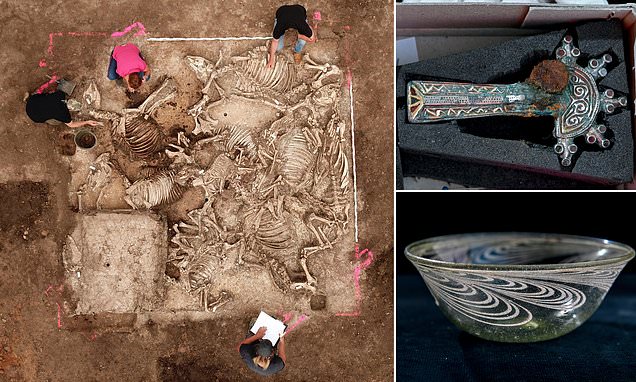Debra
The Living Force
Possible Kantekian descendants being found all over the place these days it seems.
A harem for the hereafter: Tomb of an ancient Germanic lord is unearthed with a circle of six women around a cauldron who 'may have been killed or sacrificed themselves' on his death 1,500 years ago
The complex grave of a Germanic lord or prince who lived 1,500 years ago during the Great Migration has been unearthed in Saxony-Anhalt, near Brücken-Hackpfüffel.

Experts say the site is the country's most important archaeological find for 40 years and have kept the exact location of the dig a secret to stave off thieves.
Excavations got underway when builders were clearing land for a new chicken farm, and stumbled across the cemetery of a royal court.
Despite the high-ranking status of the person entombed within, the researchers have yet to locate the remains of the prince they suspect was laid to rest there.
They speculate his ashes may be inside a bronze cauldron in the central tomb, which is around 13 feet by 13 feet in size.
The cauldron, the focal point of the mounded tomb, is surrounded by six women buried in a radial alignment from the pot, like the hands of a clock, The Times reports. [...]
[No Pictures of the six women or the caldron were included in the article.]
It also holds the remains of eleven animals, including cattle, horses and dogs. (Pictured Below)

Initial estimates date the site as being from between AD480 and AD530, a period of time following the fall of the Roman Empire which saw many Germanic tribes, such as the Huns, invade territories which were no longer under Roman protection.
'The cemetery has almost 60 graves,' said archaeologist Arnold Muhl.
'In the graves, among other things, a glass decorated bowl, a spindle whorl made of glass, several silver-gilded robe clips, a sword and a shield boss made of iron as well as a gold coin of the Eastern Roman emperor Zeno around 480 were found. [...]



This elaborate vestment clasp lies in the workshop of the Landesmuseum für Vorgeschichte for further examination. The clips, which include pieces of snagged textile, are thought to indicate the presence of a Germanic tribe, either the Longobards, Alemanni or Thuringians [...]

 www.dailymail.co.uk
www.dailymail.co.uk
A harem for the hereafter: Tomb of an ancient Germanic lord is unearthed with a circle of six women around a cauldron who 'may have been killed or sacrificed themselves' on his death 1,500 years ago
- Six women believed to be concubines were found buried in a radial arrangement in a central tomb
- Researchers have yet to find the remains of the high-ranking lord or prince that the tomb is dedicated to
- Ashes may be inside the remains of a cauldron found in the central tomb alongside animal burials and gold, silver and glass items
The complex grave of a Germanic lord or prince who lived 1,500 years ago during the Great Migration has been unearthed in Saxony-Anhalt, near Brücken-Hackpfüffel.
Experts say the site is the country's most important archaeological find for 40 years and have kept the exact location of the dig a secret to stave off thieves.
Excavations got underway when builders were clearing land for a new chicken farm, and stumbled across the cemetery of a royal court.
Despite the high-ranking status of the person entombed within, the researchers have yet to locate the remains of the prince they suspect was laid to rest there.
They speculate his ashes may be inside a bronze cauldron in the central tomb, which is around 13 feet by 13 feet in size.
The cauldron, the focal point of the mounded tomb, is surrounded by six women buried in a radial alignment from the pot, like the hands of a clock, The Times reports. [...]
[No Pictures of the six women or the caldron were included in the article.]
It also holds the remains of eleven animals, including cattle, horses and dogs. (Pictured Below)
Initial estimates date the site as being from between AD480 and AD530, a period of time following the fall of the Roman Empire which saw many Germanic tribes, such as the Huns, invade territories which were no longer under Roman protection.
'The cemetery has almost 60 graves,' said archaeologist Arnold Muhl.
'In the graves, among other things, a glass decorated bowl, a spindle whorl made of glass, several silver-gilded robe clips, a sword and a shield boss made of iron as well as a gold coin of the Eastern Roman emperor Zeno around 480 were found. [...]
This elaborate vestment clasp lies in the workshop of the Landesmuseum für Vorgeschichte for further examination. The clips, which include pieces of snagged textile, are thought to indicate the presence of a Germanic tribe, either the Longobards, Alemanni or Thuringians [...]

Ancient Germanic lord is unearthed in a 1,500-year-old tomb
Experts say the site in Saxony-Anhalt is the country's most important archaeological find for 40 years and have kept the exact location of the dig secret to stave off thieves.
